Hands On with USB Type C: Reversible USB Connectors
by Joshua Ho on September 11, 2014 9:00 AM EST- Posted in
- Smartphones
- Mobile
- Laptops
- Tablets
- USB-IF
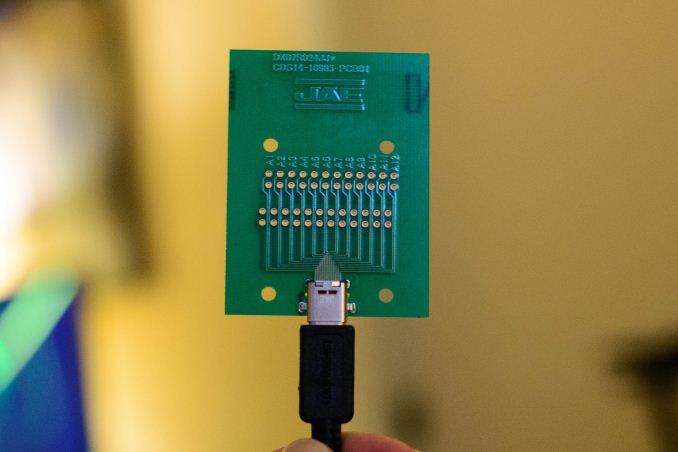
Today, the USB-IF brought me in to see the long-awaited USB Type C cables. We've written about this before, but for those that aren't familiar with this new USB spec, the USB Type C cable and USB 3.1 spec are designed with the future in mind. As a result, there are a lot of new features to talk about. We'll start with the USB 3.1 spec before we get into the Type C connector.
With USB 3.1, we see a few key improvements. Peak throughput goes to 10 Gbps from 5 Gbps, which translates to a peak of 1.25 GB/sec. In a demo of an early controller with two SSDs attached to the system I saw peak throughput of 833 MB/sec. As a side note, I also saw a demo of wireless USB connectivity from smartphone to laptop and laptop to smartphone, which was definitely pretty cool. Getting back to the USB 3.1 spec, USB Power Delivery 2.0 (PD) makes it possible for USB to supply up to 100 watts, and coexists with the BC 1.2 spec that is used in USB power adapters to charge phones so a single port would be able to provide power for both systems. In addition, USB PD 2.0 allows for power to go both ways without changing the direction of the cable, so a laptop would be able to send and receive power from the same port. Finally, USB Type-C extensions mean that it's possible to do all kinds of interesting applications over USB ports, such as sending audio and video data. It's even possible for a USB Type C port to send PCI-E data through the connection for use cases such as a two in one convertible tablet.
This opens up the possibility for a dock scenario where a single cable to the monitor can charge a laptop and also mirror the laptop's display onto the external monitor, and the external monitor would also be able to serve as a USB hub for a keyboard, mouse, headsets, flash drives, and other USB peripherals. While the laptop charging aspect and integrated USB hub in display wasn't demonstrated in the prototype I saw, everything else was fully working as shown in the photo above.
I was also able to get some photos of the cable and receptacle. Unfortunately it took flash to really show the detail in the connector but it definitely will be a great standard for all kinds of applications. While I'm sure that there will be differences in the final product, the reversible plug works just like expected and could be quickly inserted from behind the back. The USB-IF believes that this standard will show up in products shipping in 2015. It does seem that the connector is a bit less compact than microUSB, but the benefits outweigh this increase in size.


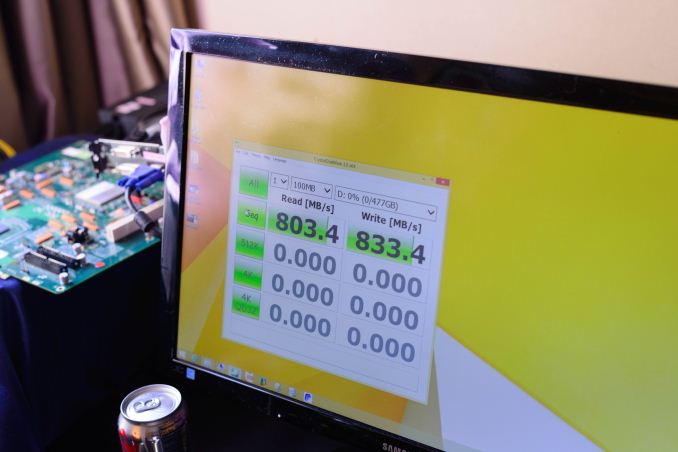
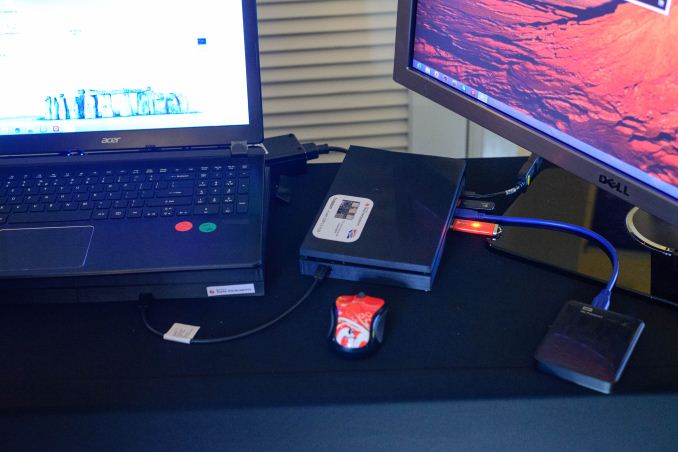
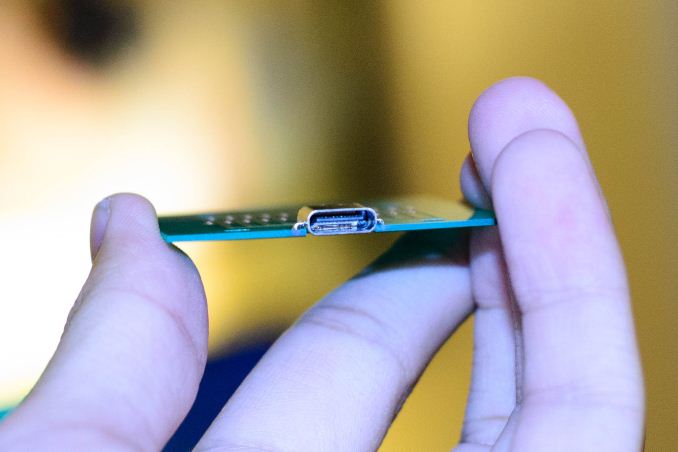
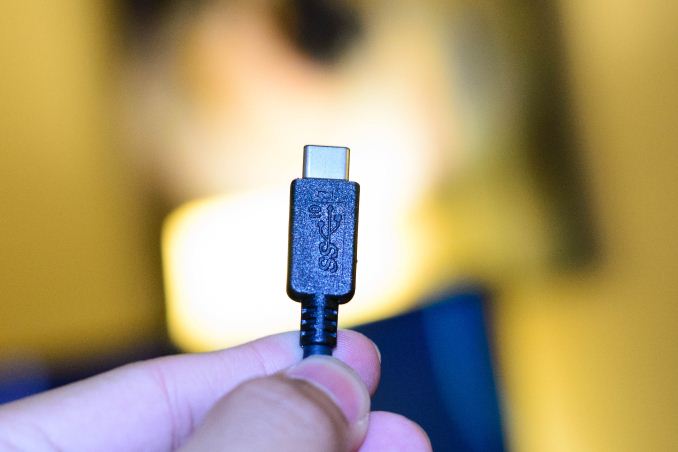
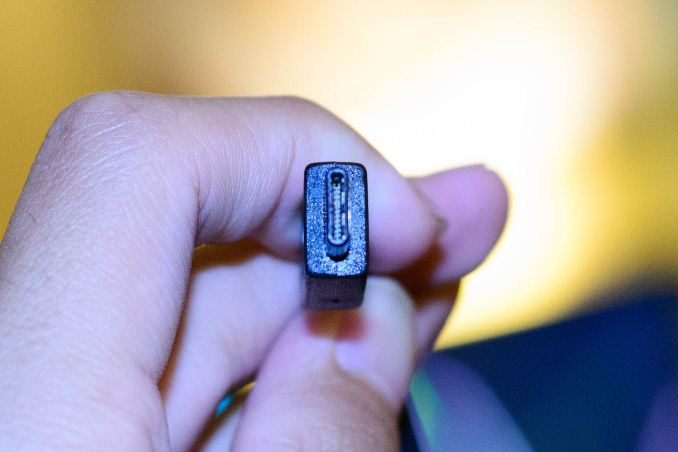








91 Comments
View All Comments
YaBaBom - Thursday, September 11, 2014 - link
Typo: "Peak throughput goes from 10 Gbps from 5 Gbps," --the first 'from' should be 'to'JoshHo - Thursday, September 11, 2014 - link
Fixed.YaBaBom - Thursday, September 11, 2014 - link
I also wonder about durability of a connector carrying 10Mbps and 100 wattskyuu - Thursday, September 11, 2014 - link
Why would the speed of the connection or some extra voltage affect the durability of the connector?Gigaplex - Saturday, September 13, 2014 - link
You need high quality connections for high bandwidth signaling like this. If there's a slightly poor connection it could kill the 10Gbit signaling but the same poor connection might work just fine for legacy 480Mbit.Friendly0Fire - Thursday, September 11, 2014 - link
"Finally, USB Type-C extensions mean that it's possible to do all kinds of interesting applications over USB ports, such as sending audio and video data. It's even possible for a USB Type C port to send PCI-E data through the connection for use cases such as a two in one convertible tablet."Is it bad if my first thought was that maybe, just maybe, this'd make external GPUs viable? Perhaps a single port wouldn't be enough, but if you can use two in parallel you could theoretically have both power and data go through USB purely. That'd be rather neat.
SleepyFE - Thursday, September 11, 2014 - link
The PCIe v2 x16 (standard desktop GPU) has 64 Gbps throughput, so we're a bit off. On the other hand, the SLI and Crossfire sometimes use only half that throughput (PCIe v2 x8) for the second GPU. So three or four connectors would work. Though i would only use them for data and put a standard PSU in the case that would house the GPU. That way you keep the price down and you can do some serious gaming on any laptop.DanNeely - Thursday, September 11, 2014 - link
Probably not for most gaming. Bandwidth is getting there; but USB doesn't have the QoS (latency and consistency) to avoid a bit of either latency or occasional lag bursts. For non-gaming use where 50-100ms for buffering isn't a major problem USB3 should be golden.SleepyFE - Thursday, September 11, 2014 - link
Yeah, latency might be a problem. We won't know until someone tries.Gigaplex - Saturday, September 13, 2014 - link
Thunderbolt GPUs have been attempted but haven't come to market in any meaningful sense. If they can't operate properly on Thunderbolt, then PCI-e over USB isn't likely to help.